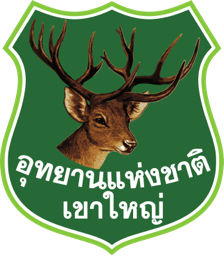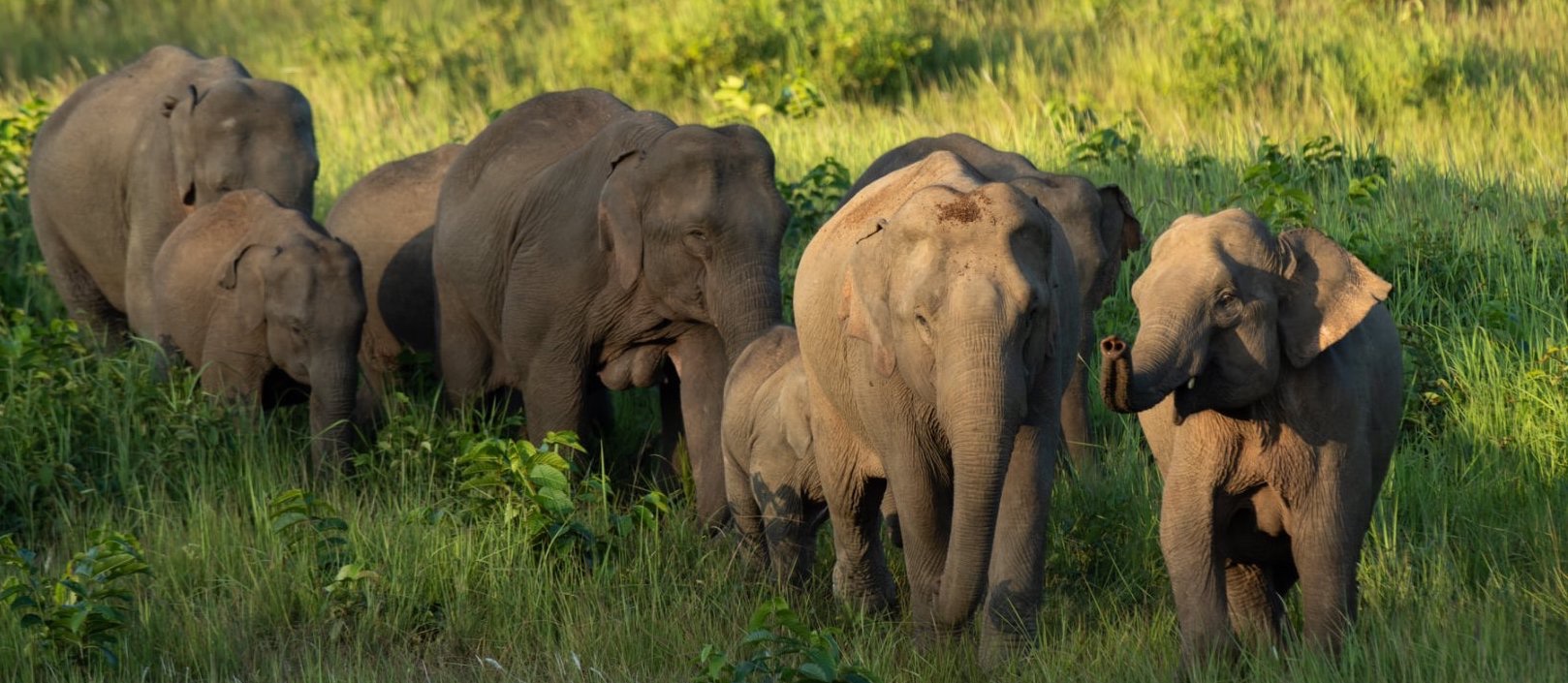
Mammals
Surveys have found over 70 species of mammal at Khao Yai. Frequently seen animals include the Asian elephant, gaur, dhole, barking deer, sambar deer, white-handed and pileated gibbons and pig-tailed macaques. Other important fauna present include the leopard cat, Asian black bear, serow, Malayan porcupine, black giant squirrel and smooth-coated otter. This diversity of mammals indicates the good ecological health of Khao Yai National Park
Asian Elephant
Scientific Name : Elephas maximus
The elephant is the biggest mammal found in Khao Yai National Park in an estimated population of 140-200. The subspecies found in the Park is the mainland Asian variety, Elephas maximus indicus. These elephants have an average Mostly with a shoulder height of 2-4 metres, weight of 3,000-5000kg and average lifespan of 60 years. Cow elephants carry their young for 18-22 months and give birth to one calf at a time.
Elephants are herbivores, and their favourite foods are bamboo, ginger, wild bananas and grasses. They also scrape salt licks for essential minerals. They forage for 16-18 hours a day, and sleep for only 3-4 hours. They eat about 10% of their body weight or 200-400kg a day, but digest only 40% of it. The remainder is excreted as elephant dung, which is manure for forest trees and food for other animals.
Elephants move in herds with complex social relationships. Members share duties of danger lookout and looking after young calves. The herd is led by a “matriarch” and consists mostly of cows and calves. As bull elephants reach maturity, they separate from the herd.
Where to find them
Scattered throughout the Khao Yai area, elephants forage on grasslands and around salt licks. They might be walking along the road right in front of you!
Did you know?
Wild elephants are the Umbrella species and help spread plants. The droppings are food for insects and an excellent fertilizer. high cutting comes to eat is beneficial for smaller animals. And the paths that elephants walk have become routes for wildlife and people to take advantage of.


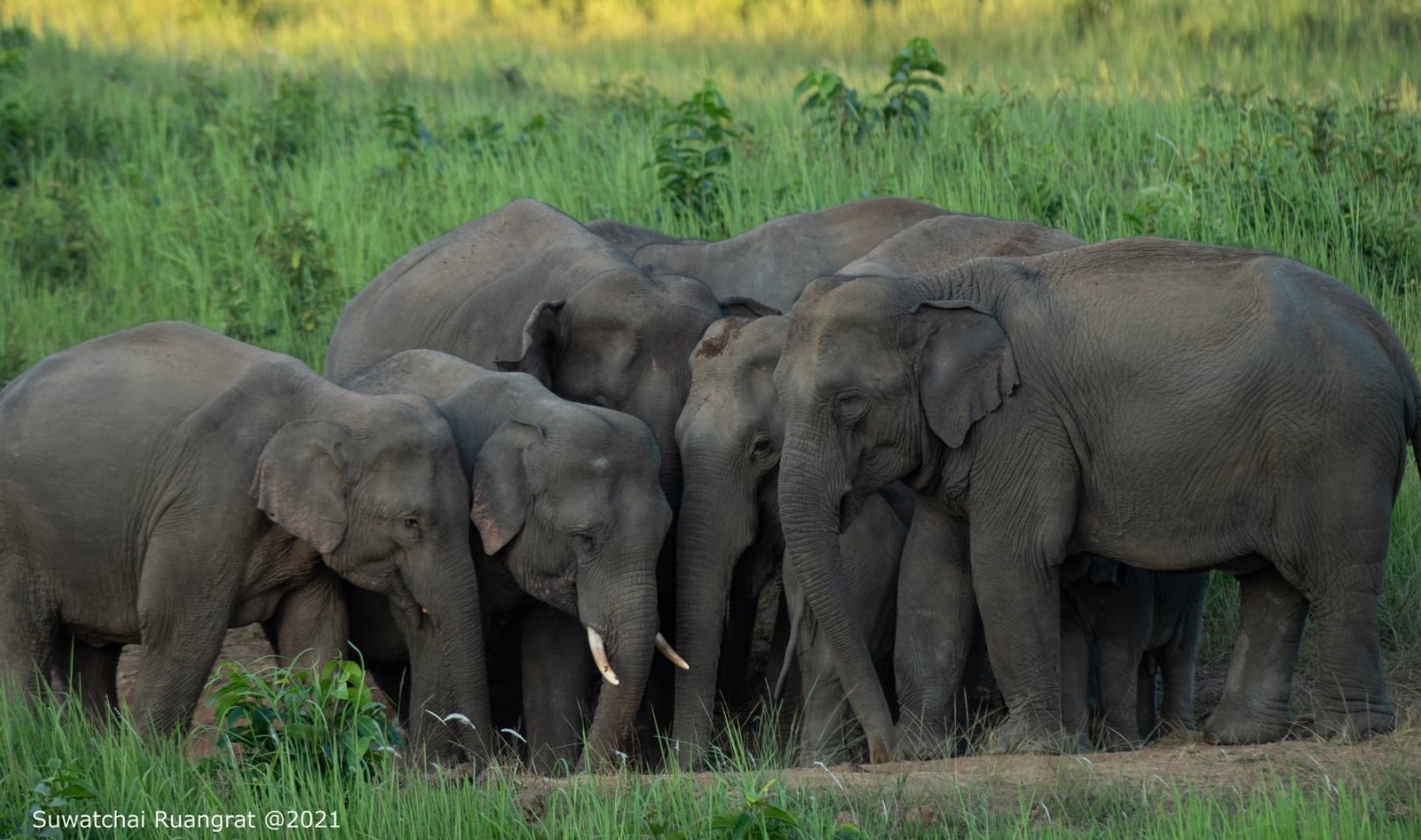
Gaur
Scientific Name : Bos gaurus
This big herbivore can conceal itself in nature and adapt to different environments. They can be found in many forest types near water as they have an insatiable thirst. Their diet is leaves, grass and salt licks, and they will alternate between grazing and sleeping throughout the day.
The gaur is an even-toed, bovine ungulate with a shoulder height of 170-185 cm, weighing 650-900kg. It has a short, glossy black or black-brown coat, off-white legs as if it is wearing socks, an ashy-grey or dirty white upper head and a prominent ridge on the back. Both bulls and cows have curved horns which are tipped with black with a yellow base. Under the skin are glands making a slightly pungent smell.
Gaur are not aggressive unless provoked, or during the mating season. They mostly congregate in herds, made up of one mature bull, cows and juveniles, numbering from less than 20 to 60 – 80, or even 100 in some areas. As bulls mature, they may establish their own herds. A younger bull may become solitary but rejoin the herd in the mating season. They have a long lifespan of 25-30 years. Gaur can mate all year but mostly during November-December. There are 9 months of gestation for a single calf.
Gaur can live in a range of forest conditions, particularly dry and montane forests. Their diet is leaves, grasses and salt licks. They graze and sleep on and off all day in Khao Yai National Park.
Where to find them
Gaur can be found throughout the National Park, but more often in its eastern part.




Dhole
Scientific Name : Cuon alpinus
The dhole, one of two wild canines in Thailand, is the only predator of deer in Khao Yai National Park. It is larger than a fox and proportioned like a dog, weighing 10-21kg. The females are smaller. It has a long body and coloured red-brown with white-yellow cheeks, chin, throat and chest. It has small ears, and a long brush tail tipped with dark grey or black. It has a lifespan of 15 years and becomes sexually mature in 2 years. Gestation is 2 months for litters of 4-6 puppies.
It is a rare species and the only extant member of the Genus Cuon. They live in packs of 6-12 and have excellent senses of hearing, eyesight and smell. Pack hunting enables them to hunt larger species such as sambar deer, muntjac, mouse deer, gaur and wild boar. Khao Yai National Park gives many opportunities to see the pack hunting its prey.
By its nature, the dhole avoids contact with humans and likes water and often goes into the water after a meal. They like to soak in shallow water whatever the temperature
Where to find them
Grasslands close to water, such as Nong Pakchi, Sai Sorn basin and Nong Khing



Sambar Deer
Scientific Name : Rusa unicolor
Sambar Deer is the largest deer in Thailand and Southeast Asia with a shoulder height of 140-160cm and a weight range of 185-220kg. The stag is larger than the hind and they have short, dark-brown fur. It has a shaggy and brown-yellow coat which is denser and less bright than the muntjac Khao Yai’s other deer species, with a short bushy tail.
Sambar deer live in the deep forest, emerging to forage by pathways, streams and open grassland, preferring leaves and shoots to grasses, but loving salt licks. They are generally solitary except for the mating season and forage from evening to early morning, sleeping during the day in dense undergrowth or soaking in mud to avoid insects. In the mating season, stags are very aggressive, very possessive of hinds and fight fiercely over them.
Mating season is generally November to January. Sambar deer become ready to mate at 18 months. A single birth is carried for 8 months to the start of the rainy season. Fawns are able to forage by themselves after a year or so.
Where to find them
They are easy to find by day or night when they venture out of the deep forest to graze the open grasslands at the forest’s edge



Barking Deer / Muntjac
Scientific Name : Muntiacus muntjak
This is a small deer about 1 metre long and 50cm tall, weighing 14-18kg. The stag has small antlers with two branches about 15 cm long, while the hinds are without antlers at all. The coat is a red-brown and it is identifiable from large tear-glands and deep-set eyes. The stag has “tusks” to help with self-defence. Hinds are ready for mating aged a year and a half, and give birth to one fawn. Barking deer fawns have white dappling which disappears by the age of 6 months.
They like to eat young leaves, bamboo shoots, fruit of the Malacca tree and wild mangoes, and have prodigious thirst. They live solitary in dense grasses or in the forest, except during mating when they form pair bonds. They forage in the evening and early morning, sleeping under vegetation during the day. They make a sound similar to a barking dog when startled.
Where to find them
They are easy to find by day or night, when they venture out of the deep forest to graze the open grasslands at the forest’s edge.



Lar Gibbon / White-handed Gibbon
Scientific Name : Hylobates lar
The Lar gibbon has both white and black hands, while the back of its hands and feet are white, with a white line around its face. The face and ears are black, hands are long and it has a slim body with no tail. It has a lifespan of 30 years and the Lar gibbon family consists of the two parents and their offspring. Gibbons mate at around the age of 7-8, experience 8 months (210 days) of gestation and usually deliver one baby. Weaning is at 18 months and the baby gibbon is attached to its mother for 2 years. When it is 8-9, it leaves the family group to form a new family.
Gibbons can live in many kinds of forest - mixed deciduous forest, dry evergreen forest and rain forest. They prefer trees with overgrown foliage. They forage for food from morning to evening and sleep in the trees. Many trees may be used for sleeping nests in the territory of each family. These trees are usually close to food sources, and their diet consists mainly of young shoots, leaves, fruit, and some kinds of insect, with fruit predominating. They drink from licking leaves or scooping out of tree hollows.
They swing from branch to branch and spend most of the day in the high canopy. They like to issue their distinctive calls from the trees at sunrise in the early morning. As the day heats up, they come down to seek shade. When they are startled, they swing away along the branches with their arms. Hawks and pythons are their main natural enemies.
Did you know…?
White-handed gibbon in Khao Yai National Park crossbreed with Pileated Gibbon and produce a hybrid gibbon, which has a different shape including vocals This is because Khao Yai National Park is the only place in the world where the two species of gibbons live in the same area.




Pileated Gibbon
Scientific Name : Hylobates pileatus
Males are black and females are white, but newborn babies are creamy white. By the age of 4-6 months, the chest hair becomes darker in a triangle shape pointing downward, while hair on the head changes to black, at the middle in a circle. At the age of 3-4, the male’s hair changes to black all over except for the eyebrows and the genitalia. The back of his hands and feet are grey with a circle around the face, where the hair is white. Pileated gibbons eat fruit, shoots, birds’ eggs and insects. Like other gibbons, they mature at around 7-8 years old, and carry a single baby for 8 months.
Tracking gibbon behavior in the forests of Khao Yai, they can generally be seen, even close up, but to see them on the mountains in nature, visitors should use Nature Trails at km. 33 to Nong Phakchi, either Ding-diw to Nong Phakchi or Ding Diw to Sai Sorn reservoir. To track gibbons, dress carefully without bright colours, be very quiet and carry binoculars, as gibbons like to live near the top of trees.
Did you know…?
Khao Yai National Park is the only known zone of contact between the white-handed gibbon and the pileated gibbon. These two species usually live in separate habitats and territories don’t overlap.



Northern Pig-tailed Macaque
Scientific Name : Macaca leonina
A short and plump monkey with short grey or brown hair and a long face. The hair on the head is similarly short and grey or brown with a tuft like the bottom of a shell, with paler hair on the belly and a rather short tail. The female is smaller with less hair covering the forehead than the male. Macaques eat fruit, seeds and insects and store food in their cheeks, bringing it out to eat with their hands. They prefer being on the ground to being in trees, but generally sleep in the trees.
Macaques start mating at the age of 3-4 years and can mate in any season. Gestation is 5-7 months for one offspring. Their lifespan is 25 years and both males and females may take multiple partners, with no pair bonding.




Leopard Cat
Scientific Name : Prionailurus bengalensis
The leopard cat is the size of a house cat but somewhat slimmer, with a weight of 3-7kg. The body is 44-107cm long and the tail 23-44cm long. It has a black-light brown coat and white belly, with rose-shaped markings on its body and tail. The tip of its tail is in sections. 4 black parallel stripes run from the forehead to the throat. The leopard cat has a small tail, short jaw and round ears.
It feeds during the day, both on the ground and in the trees, preferring to lie in tree hollows, and feeding on amphibians, reptiles, birds, fish and insects, and scavenging on carcasses. Gestation is 65-72 days for a litter of 1-4 kittens.

Asian Black Bear
Scientific Name : Ursus thibetanus
The Asian black bear is a large bear about 120-150cm long, weighing 100-160kg. Its fur is long and coarse, and black all over, with a V-shape under its throat. The bear, which walks on its heels, has large ears, a black nose, and curved sharp claws. It has a long muzzle and a short tail, with white or yellow at the tips of its feet. Its vision and hearing are not very sensitive, but its sense of smell is excellent. As an omnivore, it will eat fruit, young leaves, small animals, and insects, but especially likes honey and bee larvae. Bears prefer montane forest and generally forage at night, sleeping in bowers or caves by day. They can climb trees and swim well. The Asian black bear is by nature aggressive and lives either solitary or in groups of two or three. While they like to fight, they tend to avoid humans. When wounded or cornered, they can be ferocious. Females are pregnant for 7-8 months and give birth to 1 or 2 cubs in their caves or bowers. They will look after their cubs until they are somewhat grown and they are ready to have new cubs, after which the older cubs will fend for themselves.
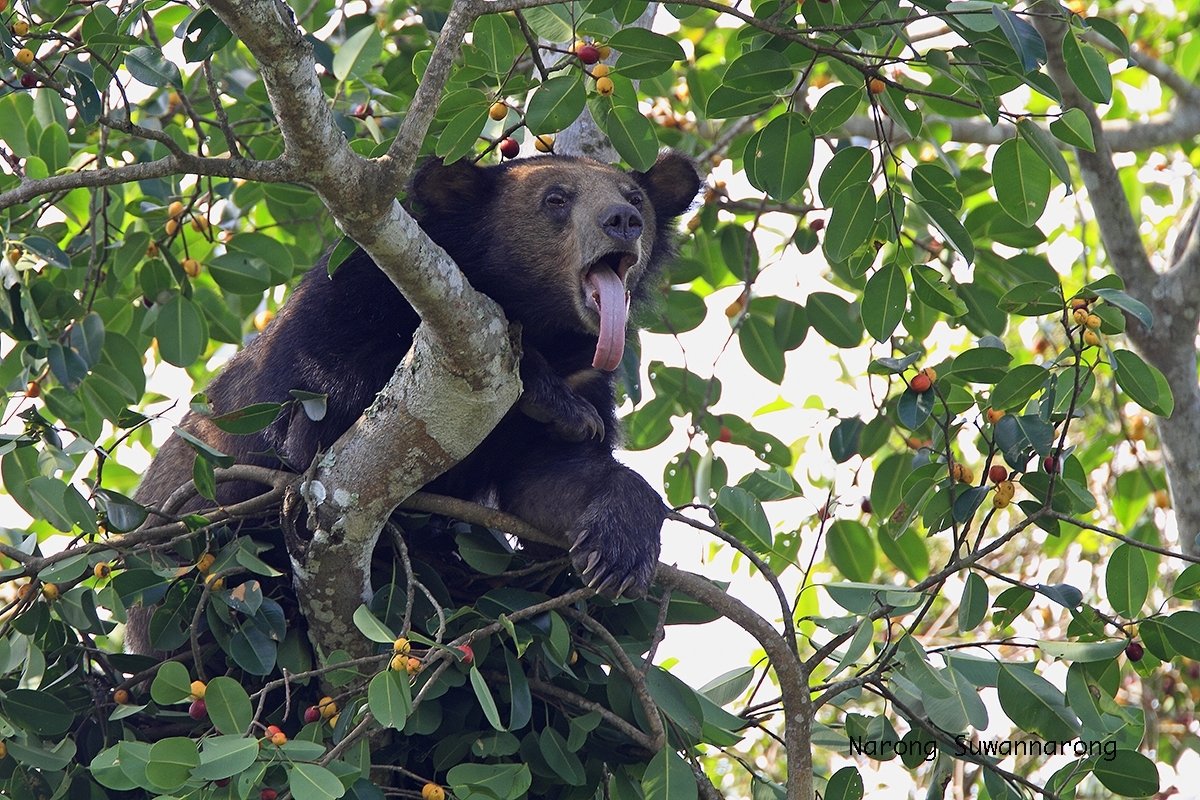

Serow
Scientific Name : Capriconis sumatraensis
The Serow is one of Thailand’s protected animals. It looks something like a sheep with short body, long legs and long black coat which may have streaks of white. It has a mane of stiff hair on its neck that runs from its head to the base of its tail, but is clearly visible from its head to its back. The front of the skull is flat with two large pricked-up ears and a pair of tapering conical horns, curved slightly backwards, with serrated ridges at the base. It has prominent tear glands under its eyes. These glands produce a pungent secretion to mark its territory. It has a short, bushy tail. Serow prefers living solitary on mountains, able to move nimbly on the cliffs. They are highly territorial and have regular defecation spots. They never graze far from their resting spaces, in the evening and in the morning. They eat grasses, ferns, leaves and shoots. By day they hide in the undergrowth or under overhanging rocks, and so are hard to find in Khao Yai National Park.
Malayan Porcupine
Scientific Name : Hystrix brachyura
As rodents, porcupines are related to rats and squirrels. They have large and stout bodies. They have a lifespan of 20 years and are 65-73cm long, and weigh up to 27kg. They have a long head and nose. Fur on the face, neck and belly is fine and brown. From the side and the back of the neck to the top of the back, the rough fur is a dark black. The large quills are used in self-defence and protrude separately from the middle of the back to end of the tail, and range in length from 5m to 30cm. They are white with a black band around the middle of the quill, and hollow inside. When a porcupine is swaying, its tail makes a loud noise. When threatened by an adversary, the porcupine will stamp its feet and the quills become erect, and it will shake its tail to make a loud sound. The porcupine cannot voluntarily discard its quills, but they detach easily, and having impaled an adversary, they will detach. They have whiskers 10-20cm long serving as an extra sense. They can adapt to a range of habitats and forage by night. By day, they hide in burrows.


Black Giant Squirrel
Scientific Name : Ratufa bicolor
The black giant squirrel is the largest squirrel in Thailand with a weight of 1-1.6kg. Fully grown, the head and body are 33-37.5cm long, with the long and bushy tail adding another 42.5-46cm. The body and tail are mostly black, with some individuals having brown haunches or at the base of the tail. The cheeks and the belly are yellow or cream. They like to live in the high forest canopy and can be found in both rain forest and mixed deciduous forest. They forage by day and sleep by night, and can frequently be seen in Khao Yai National Park

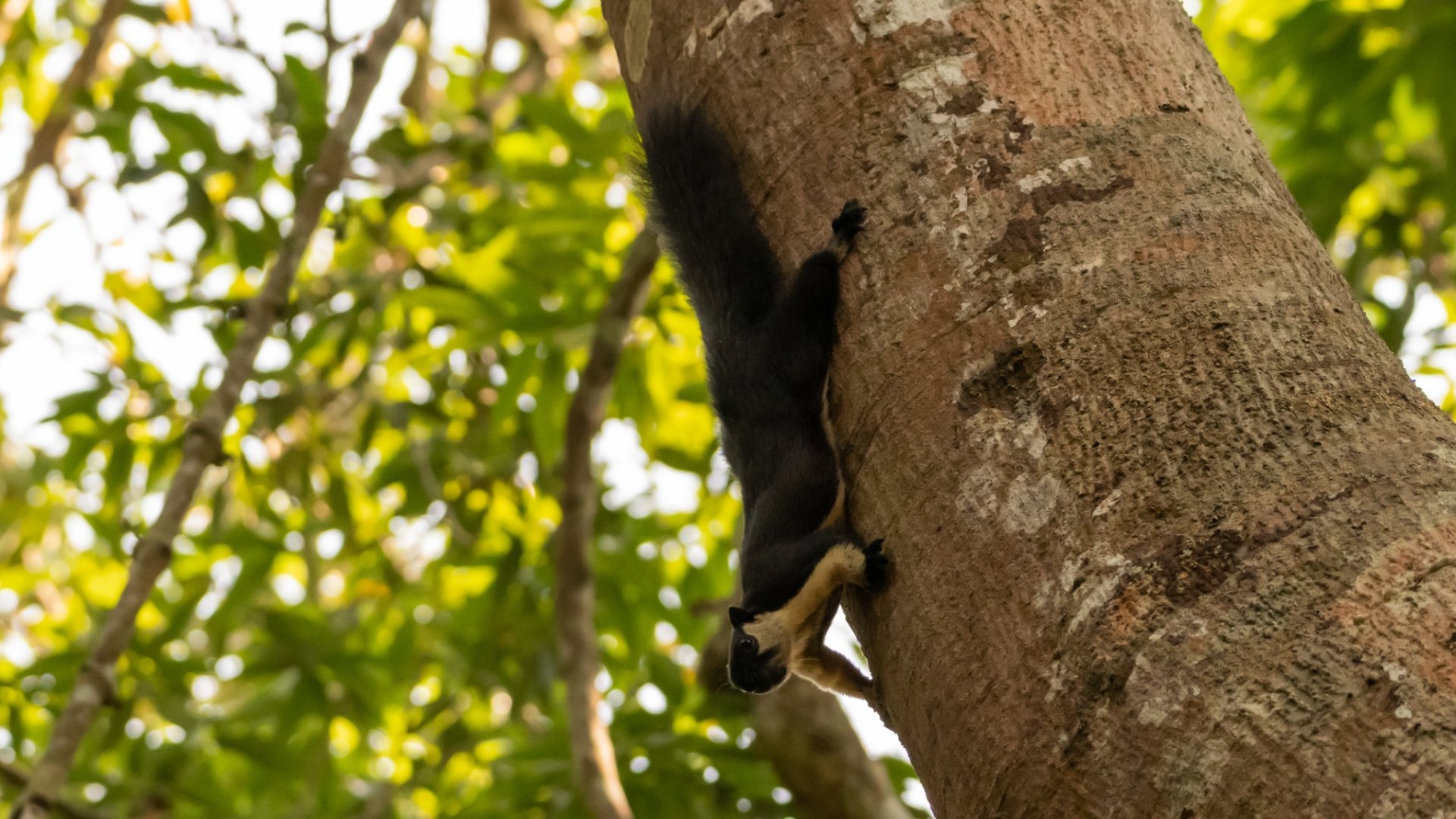
Smooth-coated Otter
Scientific Name : Lutrogale perspicillata
This otter has a smooth coat and the end of its tail is clearly flattened. It has straight whiskers. Lower jaw, cheeks, throat and upper chest are yellow-white while the upper body is dark brown, and the lower body is lighter, either brown or grey. The tail is very long, more than half the length of the head and body together, and the paws are a pale colour. Its diet is fish and otters can be found in streams, swamps, canals, ponds and river basins, and low level water sources. They are not very agile on land and congregate in groups. They hunt fish cooperatively by driving them in a semicircle to shallow water where they are caught and eaten. They mostly mate at the start of the year, gestate for 63 days and become fully mature at 3 years, having their first pups at the age of 4 years.



Northern Slow Loris
Scientific Name : Nycticebus bengalensis
This mammal is actually a primate in the Lorisidae family, and can be found in all regions of Thailand. The Northern slow loris was only recently recognized as a separate species. It weighs 900-1400 g. Its ear lobes are clearly visible with the ears buried in the fur on the head. The fur colour can vary in different areas from grey-cream, cream or light brown to dark orange. A brown stripe runs down its back to the tail. Fur around the eyes has a darker colour. During the day, its movements are very slow, but it becomes quicker at night when foraging for food, and when being blown by the wind, the origin of the Thai name “Ling Lom”. When startled, it will cover its face with its arms, the origin of another Thai name, “Nang Ai”. It is not often that they show themselves in Khao Yai National Park.
Binturong
Scientific Name : Arctictis binturong
This carnivore is a viverrid in the same family as civets and genets. Its face resembles a bear and it is sometimes called a “bearcat”, in Thai “Meekhor”. It has a thick coat of coarse black hair. The tail is bushy like a squirrel, earning another Thai name, “Mee-krarork”. The tail is prehensile and able to grip branches. The ears are rounded and terminated by tufts of black hair. Hair on the head is grey, but some binturongs have white hair on their face. They mostly forage at night and rest by day in tree hollows or bushes. Usually solitary, it is possible to sometimes to see a small group, such as a mother with a pup. Its diet is fruit, insects and small reptiles. It is an exceptional tree-climber with its prehensile tail gripping one branch after another. It can also swim well. Like the loris, it is rather rare in Khao Yai National Park.

